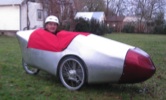If they are such a good idea why are they not widely used?

Presentation to Kiwanas Sept. 2011
Your organization works to change the world one child and one community at a time. Not being very group social I follow Ghandi's advice and through direct action, try to be the change I wish to see in the world, . Concern for the safety and health of children and animals motivates many of the actions I take. 2.3 million drivers and passengers a year are treated in emergency rooms for motor vehicle related injuries and over one million animals a day are killed by motor vehicles. My attempt to minimize the harm I do has been a bicycle and now the enclosed bicycle, pedal car, cycle car, or velomobile as it is most commonly called. The name velomobile has French roots because the earliest know velomobiles were side by side four wheelers developed in France during the 1920's and widely used until after World War II in the 1940's. Similar three and four wheelers were manufactured in Germany and Scandinavia with Scandinavian machines in use through the 1960's. Little occurred with velomobile development until the oil crisis of the 1970's when several American entrepreneurs designed and built solo and side by side velomobiles which were not commercially successful during the same period a Danish entrepreneur developed a completely enclosed three wheel velomobile the "Leitra" which is still produced today. Late in the 1980's Bart Verhees a Dutch engineering student designed the Alleweder (all weather) velomobile which in 1993 won a race and design contest sponsored by the Technical University in Eindhoven Netherlands. The contest received so much publicity and interest that it created demand for velomobiles, spawning a new industry in Holland which has spread to Germany, Switzerland, Poland, Belgium, Russia, Denmark, Canada, Australia, and the US. There are three velomobile manufacturing startups in the Northwest at this time but the buyers are still early adopters. Design and materials are rapidly evolving into lighter and faster machines. This week in Battle Mountain Nevada velomobile riders and builders are trying to top the 84 mph record. This summer around forty velomobile riders pedaled form Portland to Washington DC in 24 travel days, often averaging 25 to 30 mph. up to 160 miles in a day.
One might wonder why a weather protected, comfortable reasonably fast vehicle which is ten times safer than many motor vehicles that can save an average user $8,000 a year in transportation costs does not have wider acceptance. The answer is found in behavioral brain research begun in Italy during the 1970's. We have cells in our brain called mirror neurons which compel us to copy what those around us do. The neurons are vital for social and language skills but can suppress creativity and experimentation. It is extremely difficult to stray from the norm and velomobiles are not the norm, motor vehicles are. Various cultures have suggested ways to break from the heard instinct such as prayer, meditation, enlightenment, ritual, drugs and etc. I like to believe that prayer helps me do what I think is right but maybe it is just a mirror neuron deficiency. I try to use the velomobile for all my travel and errands where I cannot conveniently walk, a small trailer allows me to carry bulky items like lumber and plants.
Another line of behavior, and marketing research shows us that if 11% of a population begins to do something that the rest will follow, perhaps some trigger to the mirror neurons. I plan to keep pedaling around in hopes to be part of the 11% trigger.
You can learn more about the research in the books Mirroring People and The Turning Point.
Good velomobile information can be found at http://velomobiling.com/
http://velocityvelos.com/ local manufacturer
Ed Gunderson